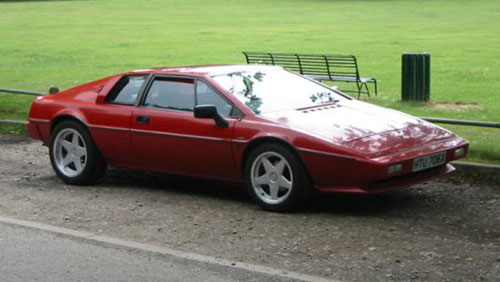Undercover Supercar:
The Early Lotus Esprit

I have a great deal of affection for the pre-Peter Stevens Lotus Esprit, in other words, for original ’76-’86 car.

Why do I love it so much? In a nutshell, it’s the unconventional ’80s supercar. In contrast to rivals like the Lamborghini Countach or the Ferrari Testarossa that followed the classic “more is more” big engine supercar formula, the Esprit adhered to the traditional Lotus mantra of performance through light weight. It was powered by a comparatively small 2 (later 2.2) liter 4-cylinder engine, offered in both turbocharged and naturally-aspirated flavors. Horsepower ranged from 140 in the earliest US-spec Series 1 (S1) model to 215 in the 1986 Series 3 (S3) Turbo HC Esprit—on paper, nothing to strike fear in the hearts of its Italian competition, but as mentioned above, the Esprit’s light weight of around 2,400 lbs was its trump card, giving it sparkling performance on par with its rivals. 60 mph came and went in less than 5 seconds for the S3 Turbo HC, and the car’s low mass benefited handling and braking as well, making the Esprit a force to be reckoned with.

I’m drawn to the early Esprit from a styling perspective as well. In contrast to the softened, rounded post-1986 Peter Stevens redesign, the first three series preserved legendary Italian stylist Giorgetto Giugiaro’s severe, uncompromising wedge shape. There’s an uncluttered simplicity to its lines that brings the perfect proportions to the fore, and the 1976-1986 Esprit just looks like a purer expression of the designer’s original intent, even if Giugiaro did admit to being a fan of the later two designers’ refreshes. The car’s lines also contrast with those of its more flamboyant rivals, and ensured the Esprit a lower level of desirability than a Countach or a Testarossa in a decade like the ’80s of conspicuous consumption. If it hadn’t starred in two James Bond films (Roger Moore’s The Spy Who Loved Me and For Your Eyes Only) it’s doubtful the Esprit would have risen out of enthusiast niche obscurity.

Naturally, as with almost all British cars of the era, there are some maddening problems, or charming quirks, depending on your perspective (and patience levels). The infamous British firm Lucas was responsible for the Esprit’s electrics, with all the (un)reliability that implies. Lotus went through several uneven financial periods during the car’s model run, and used a smattering of old and freshly engineered parts depending on the money available at any given time to be dedicated to development. The transmission, initially sourced from Citroen, was always a weak point, and the interior design, in contrast to the sheetmetal, has aged rather poorly.
As long as an enthusiast owner isn’t expecting to daily-drive the Esprit, the downsides aren’t dealbreakers, and all in all any eventual owners can congratulate themselves on having shown their taste in cars by snagging an unsung hero of the supercar scene.







